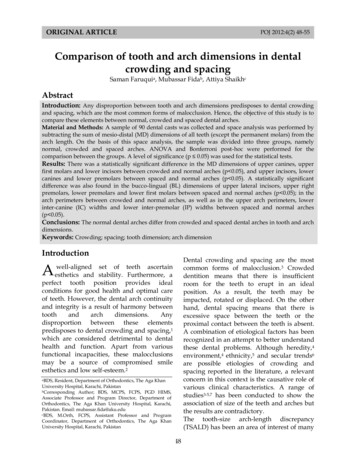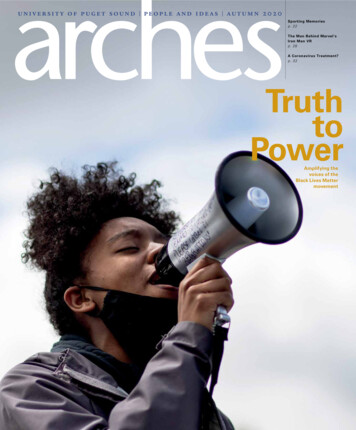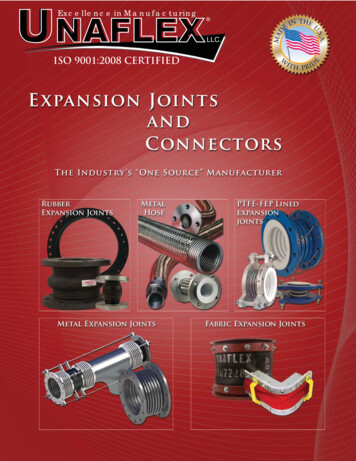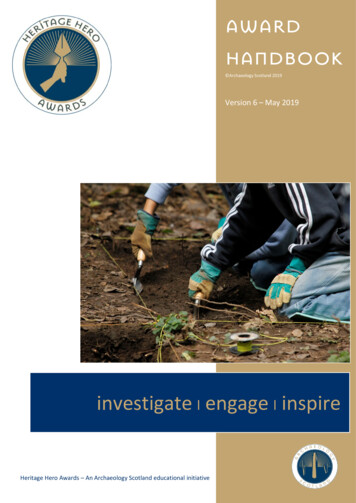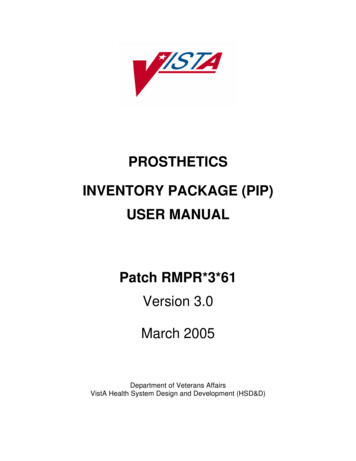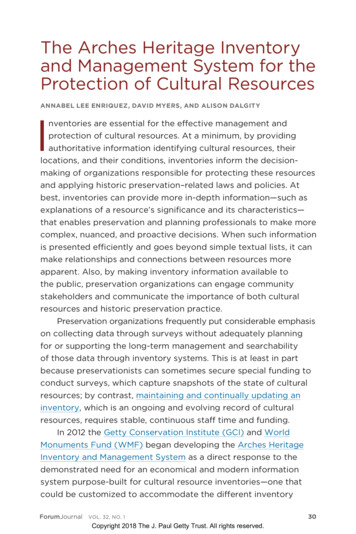
Transcription
The Arches Heritage Inventoryand Management System for theProtection of Cultural ResourcesANNABEL LEE ENRIQUEZ, DAVID MYERS, AND ALISON DALGITYInventories are essential for the effective management andprotection of cultural resources. At a minimum, by providingauthoritative information identifying cultural resources, theirlocations, and their conditions, inventories inform the decisionmaking of organizations responsible for protecting these resourcesand applying historic preservation–related laws and policies. Atbest, inventories can provide more in-depth information—such asexplanations of a resource’s significance and its characteristics—that enables preservation and planning professionals to make morecomplex, nuanced, and proactive decisions. When such informationis presented efficiently and goes beyond simple textual lists, it canmake relationships and connections between resources moreapparent. Also, by making inventory information available tothe public, preservation organizations can engage communitystakeholders and communicate the importance of both culturalresources and historic preservation practice.Preservation organizations frequently put considerable emphasison collecting data through surveys without adequately planningfor or supporting the long-term management and searchabilityof those data through inventory systems. This is at least in partbecause preservationists can sometimes secure special funding toconduct surveys, which capture snapshots of the state of culturalresources; by contrast, maintaining and continually updating aninventory, which is an ongoing and evolving record of culturalresources, requires stable, continuous staff time and funding.In 2012 the Getty Conservation Institute (GCI) and WorldMonuments Fund (WMF) began developing the Arches HeritageInventory and Management System as a direct response to thedemonstrated need for an economical and modern informationsystem purpose-built for cultural resource inventories—one thatcould be customized to accommodate the different inventoryForumJournalVOL. 32, NO. 1Copyright 2018 The J. Paul Getty Trust. All rights reserved.30
programs of preservation institutions around the world. During theinitial stages of the project, the partners identified some fundamentalchallenges that most preservation organizations, and the preservationfield as a whole, face in creating and maintaining inventory systems.These include:z complexity of cultural resource information;z rapid changes in information technology; andz lack of financial and staff resources.Arches specifically addresses these challenges to create morerobust inventory systems, advance inventory practice, and ultimatelyhelp conserve cultural resources.CAPTURING THE COMPLEXITY OF INFORMATIONSignificance and RelationshipsFirst of all, an inventory must be able to describe why a culturalresource is, in fact, significant. In the past, complex explanationswere recorded in lengthy narrative texts, but, to be truly useful,these texts need to be machine searchable in a meaningful way.Often, one must be able to discern the historical relationshipsbetween places, events, and people to get a full picture of thesignificance of a resource. Arches is designed to enable describingand then searching for such relationships.The default version of Arches allows organizations to recordinformation for six different types of resources:z Historic Resources: individual cultural resources such as historicbuildings, structures, monuments, archaeological sites, andlandscapes;z Historic Resource Groups: historic districts and other groupingsof historic resources;z People/Organizations: significant people, architects, culturalgroups, and organizations;z Historical Events: historic battles, natural disasters, and culturalmovements;z Activities: preservation-related interventions as well as surveys; andz Information Resources: photos, reports, videos, audio files, and3-D models.ForumJournalVOL. 32, NO. 1Copyright 2018 The J. Paul Getty Trust. All rights reserved.31
This Arches“Related Resource”graph highlightsthe relationshipsbetween variousresources.IMAGE COURTESY OF THEGETTY CONSERVATIONINSTITUTEIn Arches,resource recordsof any type canbe related toeach other todocument anddefine resourcerelationships.A simple example of this would be a resource record for an architect being related to the records of all the other buildings that theydesigned. Seeing these relationships often clarifies why a culturalresource or group of cultural resources is significant.Spatial InformationTo protect cultural resources, a preservation organization must notonly know where a particular resource is located but should alsobe able to view spatial relationships between resources that arenear each other and/or share common characteristics. Arches isgeospatially enabled, giving organizations the ability to easily addmultiple types of spatial data—such as points, lines, or polygons—for the same resource to one record by importing existing data; byentering coordinate or address information; or by drawing thelocation on a basemap using the Arches interface. Users can alsosearch for information spatially by drawing search boundaries onthe map and defining a buffer distance. For example, a planner canquickly search for all the cultural resources that might be affectedby a planned development.Differences in TerminologyThe terminology used to describe cultural resources may differ basedon region, culture, language, and even the person documenting theForumJournalVOL. 32, NO. 1Copyright 2018 The J. Paul Getty Trust. All rights reserved.32
resource. For example, a “carriage house” might also be referred toas a “chaise house,” “coach house,” or “coach barn.” All of theseterms describe the same type of structure, but it might be difficultto come to a consensus about which term to use in an informationsystem. Furthermore, even if a consensus was reached, the publiccould not be expected to know which term had been chosen.The Arches platform includes the Reference Data Manager(RDM), a module that manages the terminology and values thatappear in dropdown lists. Arches can store multiple terms as labelsto describe the same concept, so a user can search for “carriagehouse,” “chaise house,” or even the Spanish “cochera,” and Archeswill return all the relevant resources. The RDM helps to ensure validand consistent data entry and enhances searching.Controlled Access to InformationCultural resource data may include sensitive information, such asthe location of sacred tribal sites or fragile archaeological sites,that must be withheld from unauthorized viewers. Thus,organizations may want to control what information particularusers can view and/or edit.The administrator of an Arches system can define users anduser groups and assign permissions to each at the data-field level.For example, authorized preservation professionals may be givenfull access to make edits to all fields, while volunteers could beallowed to edit fewer fields or none at all.System Customization and Arches Version 4Because of cultural, regional, statutory, and other differences, aone-size-fits-all approach to cultural resource inventory software isnot realistic. With this in mind, Arches is designed to be as genericas possible for the preservation field while offering maximumopportunities for customization. With Arches Version 4, unveiled in2017, an administrator can determine what data fields to include intheir organization’s Arches implementation; the correspondingdata entry forms and reports will be created dynamically withoutthe need for specialized programming.ForumJournalVOL. 32, NO. 1Copyright 2018 The J. Paul Getty Trust. All rights reserved.33
Arches Version 4 adds new functionality, including an integrated map and search pagethat allows users to find data by combining text-, concept-, spatial-, and temporal-basedsearching.IMAGE COURTESY OF THE GETTY CONSERVATION INSTITUTEArches Version 4 also includes a number of other substantialsoftware features that enhance users’ ability to customize thesystem. The Arches Designer, for example, allows administratorsto dynamically determine which data fields are included in theirimplementation as well as how those data are entered and displayed.The map server enables the incorporation of locally stored satelliteimagery and other basemaps, such as historic maps. In 2018 thesoftware platform will include a new integrated online-offlinemobile data-collection app for field data collection, which will letsurvey managers customize their projects and define the scope,area, timeframe, and users for field data collection.KEEPING UP WITH RAPID CHANGES IN TECHNOLOGYA new generation of information technologies presents thepreservation field with more effective ways of managing, enriching,and disseminating cultural resource data. However, keeping trackof new technologies and applying them to preservation work canbe challenging. Arches is a modern system that incorporates thelatest technologies while remaining easy to use for those who arenot experts in specialized software such as geographic informationsystems (GIS).ForumJournalVOL. 32, NO. 1Copyright 2018 The J. Paul Getty Trust. All rights reserved.34
The move to digital documentation allows substantially morecultural resource data to be recorded, but that introduces newchallenges for managing and making usable larger amounts of dataover the long term. Arches addresses these challenges by adheringto internationally recognized standards that apply to both dataformat and modeling of cultural heritage information. For example,Arches is compliant with the standards and specifications of theOpen Geospatial Consortium, which ensures compatibility withdesktop GIS systems (such as ESRI ArcGIS, Google Earth, orQuantum GIS), modern web browsers, and online mapping services.Arches also incorporates the CIDOC Conceptual ReferenceModel (CRM), an International Organization for Standardization(ISO) standard that facilitates the exchange of information bydefining cultural heritage information entities and the relationshipsbetween them. Essentially, the CRM allows Arches to automaticallyencode data in the system so that the information is machinereadable regardless of the software used; that is, the data arenow portable and can be migrated to new systems and formats,protecting them for the future.MAXIMIZING RESOURCES THROUGH AN OPEN SOURCEAPPROACHEffective inventory programs require not only modern informationsystems to securely manage and provide access to culturalresource data but also the money and staff time to keep thosedata up to date and relevant. This can often put a strain onresource-strapped preservation organizations.With this in mind, Arches has been developed as an opensource software platform, which means that its software codecan be downloaded and modified by anyone. Arches’ code is free,although preservation organizations must host the softwarethemselves, on either a local or cloud server. Users are not subjectto annual license fees and there are no limits on how many userscan access any Arches implementation. And improvements to thesoftware code must be made available to all, so they can beimplemented by any institutions that find them useful; this helpsprevent wasteful duplication of expensive software developmentForumJournalVOL. 32, NO. 1Copyright 2018 The J. Paul Getty Trust. All rights reserved.35
efforts by preservation organizations working alone. The opensource approach applies only to the software code; as mentionedearlier, the data managed in an organization’s Arches instance canbe as open or closed as needed.Institutions do not have to rely on proprietary software companiesto release new features, but can instead develop their own. TheArches software platform is strengthened by its community of usersinteracting and helping each other through direct support and thedevelopment of features that benefit the entire preservation field.ARCHES IN ACTIONApproximately 40 organizations around the world are currentlyusing the Arches software platform to manage cultural resourceinventory information.z The City of Los Angeles is using Arches to power HistoricPlacesLA,the Los Angeles Historic Resources Inventory. The systemcontains cultural resource information from various sources—including the National Register of Historic Places, the CaliforniaRegister of Historic Resources, and the Los Angeles HistoricCultural Monument designation program—but primarily derivedfrom SurveyLA, which won a Richard H. Driehaus FoundationNational Preservation Award in 2017. The informationis open notonly to cityagencies butalso to thepublic at large.A spatial search inthe Arches-poweredHistoricPlacesLA, theLos Angeles HistoricResources Inventory.IMAGE COURTESY OF THEGETTY CONSERVATIONINSTITUTEForumJournalVOL. 32, NO. 1Copyright 2018 The J. Paul Getty Trust. All rights reserved.36
The Cane River National Heritage Area in Louisiana implementedArches to both manage its resources and publish informationabout them. The Cane River Heritage Inventory and Map includehistoric basemaps of the area as well as audio recordings of oralhistories.z Established in 1851 for military veterans, the Armed ForcesRetirement Home customized Arches to better manage theimportant cultural resources on its 272-acre historic residentialcampus in Washington, D.C.z Currently preparing its Arches implementation for a publiclaunch, Queen Anne’s County, Maryland, is recording more than300 years of its history through the people, places, and eventsthat shaped the county, the state of Maryland, and the nation.z Through a collaboration with the U.S. Department of State, theAmerican Schools of Oriental Research (ASOR) is working todocument damage to heritage caused by armed conflict in Syria,Islamic State–affected areas of Iraq, and Libya. This ASORCultural Heritage Initiatives project will use Arches to helpmanage and collect data, share information with otherinstitutions working in the same region, and eventually plan forpostwar conservation.z Based at the universities of Oxford, Leicester, and Durham inEngland, the Endangered Archaeology in the Middle East andNorth Africa (EAMENA) project uses Arches to bring togetherdata from satellite imagery and published reports. The EAMENAproject compiles and shares information about threatenedarchaeological sites and landscapes across the Middle East andNorth Africa.z A Manila-based nonprofit group, Grupo Kalinangan, hasdeployed Arches to create the Philippine Heritage Map, whichincludes survey information about cultural resources throughoutthe Philippines, supplied by both preservation professionals andvolunteers.The Kingdom of Bhutan as well as St. Kitts and Nevis also useArches as the system for their respective national inventories.Implementations are now being prepared in the United States byzForumJournalVOL. 32, NO. 1Copyright 2018 The J. Paul Getty Trust. All rights reserved.37
the city and county of San Francisco and in the United Kingdomby Historic England for Greater London and by the city of Lincoln.By focusing on a fundamental component of cultural resourcemanagement—inventories—and providing a robust system tomanage and access inventory data at no cost, the Arches teamhopes to help preservation organizations and professionals moreeffectively conserve cultural resources by being more efficient—not wasting precious resources on independently creating digitalinventory systems from scratch.In short, the Arches Heritage Inventory and ManagementSystem is a freely available modern software platform that capturesthe complexity of cultural resource information and uses the latesttechnologies to facilitate informed preservation decisions in thepresent and future. FJANNABEL LEE ENRIQUEZ is an associate project specialist at the Getty Conservation Institute(GCI), where she works on the Arches project as part of the Web and Digital Initiatives department.DAVID MYERS is a senior project specialist at the GCI, manager of its Recording and DocumentationUnit, and part of its Buildings and Sites department. ALISON DALGITY is a senior project managerat the GCI, where she heads the Web and Digital Initiatives department and is the lead projectmanager on the Arches project.TAKEAWAYExplore the Arches Version 4 demo site.VIDEOWatch the 2017 Richard H. Driehaus Foundation NationalPreservation Award video for SurveyLA.ForumJournalVOL. 32, NO. 1Copyright 2018 The J. Paul Getty Trust. All rights reserved.38
Arches' code is free, although preservation organizations must host the software themselves, on either a local or cloud server. Users are not subject to annual license fees and there are no limits on how many users can access any Arches implementation. And improvements to the software code must be made available to all, so they can be


